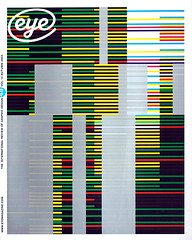Autumn 2003
Editorial Eye 49
There is a moment in Adrian Shaughnessy’s profile of Angela Lorenz where the latter talks about ‘the mythical zeros and ones in the brain of your Mac’. Somehow, it is oddly appropriate that Lorenz, a practical designer who turns the fundamentals of machine code into a kind of folk art, should use terms such as ‘myth’. It reveals an instinctive response to the way our computer-dominated world feels from the inside.
Nico Macdonald’s piece is also concerned with intuitive responses to computer processing, new maps that may help us make qualitative judgements and / or quantitative assessments by turning large, indigestible amounts of data into easily grasped images and diagrams on screen. Since ‘information overload’ is unlikely to get any smaller in the near future, the task of dealing with what Macdonald calls ‘understanding underload’ is a real and urgent challenge for designers.
Yet there are times when facts and figures, however clearly presented, are ignored by the very people who should know how to act upon them. After years of official indifference, the murder statistics of Ciudad Juárez have provided the starting point for a striking graphic ‘shout’ by a large number of Mexican poster designers, a gesture that may help draw national and international media attention to the situation.
More horror: after Hiroshima, the A-bomb’s mushroom cloud became an instantly recognisable icon of the postwar era. Yet the images collected by Steven Heller for his feature are closer to myth than science, tapping into some deep collective terror.
Alice Twemlow’s overview of graphic design conferences is accompanied by a series of fine photographs from the recent agideas conference in Melbourne and is complemented by some anecdotes and comments from several conference veterans. Ken Garland is amusing; Rick Valicenti recalls being overwhelmed and moved to tears on one occasion; Michael Worthington is deeply sceptical.
The graphic design careers of Keith Breeden, Peter Saville and Malcolm Garrett have benefited from the familiar process by which a fast-moving, unpredictable youth culture is from time to time pinned down by memorable visual images. Rick Poynor’s article examines the designers’ mature work alongside some fascinating early material: scrapbooks, sketchbooks and youthful experiments. We can detect the results of their early exposure to graphic design methods and techniques; the competitiveness and shared enthusiasms of teenagers working in the same art room; and the profound influence of a schoolteacher trained in graphic design. And none of the ‘legends’ that puzzle Dan Nadel in his review of the new Saville monograph.
Angela Lorenz’s Digital shapes and patterns, what Shaughnessy calls her ‘magnified pixel landscapes’, provide the source material for our front cover and transformed into what Lorenz, in her typically practical and disarming fashion, refers to as the ‘real thing’ of ‘ ink on paper’. JLW
John L. Walters, Eye editor, London
First published in Eye no. 49 vol. 13 2003
Eye is the world’s most beautiful and collectable graphic design journal, published quarterly for professional designers, students and anyone interested in critical, informed writing about graphic design and visual culture. It is available from all good design bookshops and online at the Eye shop, where you can buy subscriptions and single issues.

